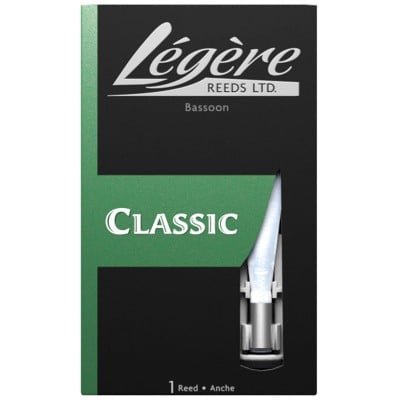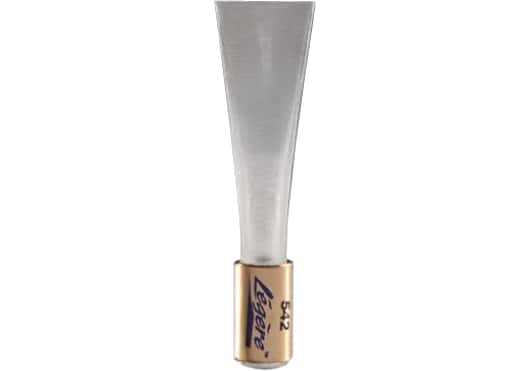Like our single reeds, Légère bassoon reeds have all the depth and warmth that elite players demand. Because they are made from our specially prepared synthetic material, the deliver all the advantages of a traditional Légère reed: consistency, durability and an instant response. Materials Légère reeds are made from polypropylene, which is approved by the FDA for use in direct food contact applications, so our reeds are completely safe to use. For more information, see our Materials page. Process Légère bassoon reeds are cut from our own unique polymer on 3-axis, computer controlled precision cutting machines. We can also measure our reeds with extreme precision using computer controlled equipment, and this allows us to maintain very tight quality control. The reeds are cut in halves using our own customized profiles which are based on a mathematical description of a reed profile rather than a model or prototype. The halves are then bonded together again using a digitally controlled system. The result is a reed which is perfectly balanced in both blades, and has just the right combination of tip thickness, heart, and flexibility. Because the process is entirely digital, we can design new reed profiles very easily. Instructions for Playing the Légère Synthetic Bassoon Reed 1. Basically the reed is what it is! Currently, we are producing reeds with a tip width of 16 mm in soft and medium strengths. Do not try to work the blades with your knife. You will only dull your knife. The polymer is about half the thickness of cane, is very brittle, and has its own grain. The only adjustment possible is to the aperture. You may close the aperture by gently squeezing the blades together about 15 mm from the tip edge. You may also open the aperture slightly by gently squeezing on the sides with your fingers about 15 mm from the tip edge. Do NOT use strong force or pliers because the reed will crack. 2. The sides have been sealed from the butt to the tip edge and it is important not to break that seal. 3. If you wish to make the reed harder, you will need to OPEN the aperture. Place the reed in hot water (approximately 90 Centigrade/ 194 Fahrenheit ) for 30 seconds. Remove with tweezers, insert a plaque and place in cold water for a minute. Be careful not to jam the plaque in so as to unseal the sides. You can also tie a string onto the reed to make it easy to remove from the hot water. If you heat the water in the microwave above the boiling point it can flash boil when the reed is inserted. This phenomenon is called super heating. To avoid this, stir the water gently with a fork before inserting the reed. WARNING: opening the aperture will allow more air but may also cause the 1 finger e to fall. (See #4) 4. If the 1 finger e falls, you may close the aperture slightly. If you need to have more stability, you may also clip the tip back as you would on cane reeds. 5. If you wish to make the reed softer, you will need to CLOSE the aperture. Place the reed in hot water (approximately 90 Centigrade/ 194 Fahrenheit ) for 30 seconds. Remove the reed with tweezers and immediately close the tip edge by squeezing the blades with your thumb and fore finger. You may also use a clamp but clamps tend to close the aperture too much necessitating the partial insertion of a metal plaque to re-open the aperture slightly while the reed is still warm. You can also tie a string onto the reed to make it easy to remove from the hot water. If you heat the water in the microwave above the boiling point it can flash boil when the reed is inserted. This phenomenon is called super heating. To avoid this, stir the water gently with a fork before inserting the reed. 6. If you have a thick walled bocal and the reed will not fit, you may ream the reed the way you would ream a cane reed. However, be careful to remove the debris from inside the tube with a rat-tail file. 7. After a period of playing (usually around 15 to 20 hours), you may notice an accumulation of debris on the inside of the blades of the reed often accompanied by a slight discoloration. This debris will actually dampen the vibrations of the reed, making it a bit stuffier, and therefore should be removed without breaking the seal on the sides. (See Caring for your reed below.) Caring For Your Reed Légère synthetic bassoon reeds are rugged and should last for many hours of playing. However, the tip edges are fragile and the reed can split or break if one tries to manipulate the aperture by squeezing the tube as one would a cane reed. (See Instructions for Playing the Légère Synthetic Bassoon Reed above) One of the best features of a Légère reed is that it does not need to be moistened prior to playing, and it is not subject to weather and humidity differences. It will warm up over the first few minutes, and should then be stable for an extended period. The reeds should be cleaned periodically with water and a mild detergent. Germicides such as Sterisol can be used to clean the reeds, but you should not assume that such products will sterilize them. You can also pull a soft pipe cleaner from the butt through the aperture to remove debris. Be careful, however, NOT to break the seal on the sides of the reed. We advise against sharing reeds or using reeds that have been tested or played by others unless the reeds have been sanitized. With proper care and maintenance, your Légère reed should provide you with many hours of playing pleasure. Many players report that our reeds can last for months.
EUR 133.00 - See more - Buy online
 (EUROPEAN COMPANY)
(EUROPEAN COMPANY) 
